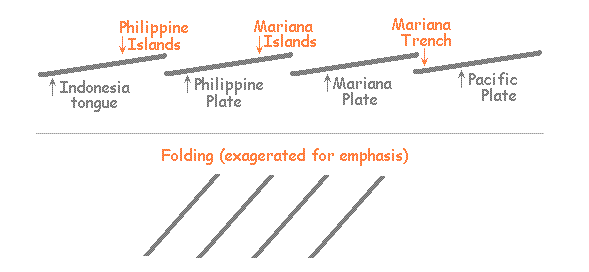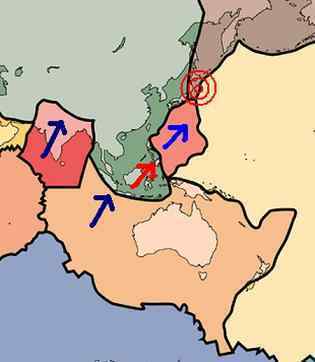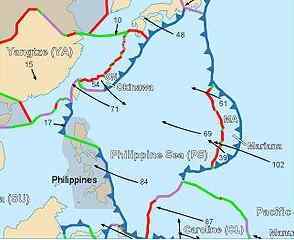
| |
 |
![]()
The folding of the Pacific plates that accompany the sinking of Indonesia during the 7 of 10 scenarios involves, as we have explained, the Mariana and Philippine plates tilting and flattening westward. This is nothing more than an existing trend, so is just a matter of the plates moving along faster in the direction they are already going. The Mariana Trench is a zone where the Pacific Plate is subducting under the Mariana Plate. The Pacific Plate curves down at this point, plunging under the Mariana Islands which ride on the Mariana Plate. The trench will be suddenly closed, so that rather than a trench there will be the Pacific Plate scraping along the Mariana Plate, and giving the Mariana Islands a temporary boost up as the plate tilts during this process. The Mariana Plate, thus tilted, will slide its western edge down along the Philippine Plate, as the Mariana Plate subducts under the Philippine Plate and this process will now be accelerating. The Philippine Plate likewise tilts its eastern side up, dropping its western side down. The exaggerated tilt accelerates the subduction of the Mariana Plate, and also accelerates the subduction of the Philippine Plate under the tongue holding Indonesia. The tilting of the Philippine Plate gives the Philippine Islands a temporary boost up also, as these islands ride on the eastern edge of the tongue holding Indonesia. Meanwhile, the tongue holding Indonesia has been plunged down, ultimately pulling both the Mariana and Philippine plates down as they fold so the Mariana Islands do not have a permanent boost in elevation. Nancy has explained this as a deck of cards, scattered on a table top, being pulled together into a deck. The plates are folded against one another.
ZetaTalk ™

If the pressure on the point where the Pacific Plate noses into Japan was
immense enough to cause the recent 9.1 quake there, what do you suppose
the pressure is on the edge of the Philippine Plate, and the vulnerable
Mariana Trench? This is why in our 7 of 10 scenarios we
predicted that these plates would fold. The Mariana Trench collapses,
tilting the Mariana Plate and pushing it under the Mariana Islands, and
the Philippine Plate tilts and pushes under the Philippine Islands. This
process has started, but hardly completed as yet. Then look at
the point where the Pacific Plate noses into the plate tongue holding
Indonesia. This again is a pressure point, and the fracture of small
platelets there shows how much pressure has been applied in the past.
The reason the Japan quake happened at this time is because the
points south have been compressing, making the Japan point the point of
greatest pressure. The Indo-Australian Plate had been tilting in mid-2010,
sinking the Indus River valley on the Pakistan/India border by 10 feet.
This plate is also rising at the New Zealand end, as the recent quakes in
Christchurch show. Indonesia has been folding like an accordion and
sinking since December, 2010. And on occasion the buoys show that the
Mariana and Philippine Plates have folded, somewhat. What now? Since
subduction under Japan has eased the pressure, the pressure will return to
points south again. This will prove to be iterative to some degree, until
the 7 of 10 scenarios in Asia have completed.
Plate tectonics involves various dramas on the plate borders - clash or
subduction bounaries, slip-slide boundaries, and stretch zones boundaries.
Where plate borders clash, one plate pushing against another, this most
often has one of the plates either riding over or pushing under the other.
Such border clashes are invariably accompanied by massive quakes in the
range of magnitude 8-10. Japan, the Andes, the West Coast of the N
American continent, and the Himalayas are examples of such border clashes.
During such clashes there will be a point where the pressure is
greatest, and that will be the spot where a quake will occur.
The Pacific is currently compressing, in step with a widening Atlantic,
all caused by the jerking around that planet Earth is enduring during the
daily Earth wobble caused by the magnetic push/pull from Planet X. The
position of the Moon and its resultant gravity pull has scant influence on
the matter. The parts of the Pacific Plate are themselves folding, down
along the island chain that forms the Hawaiian Islands and on down to the
Society Islands. These adjustments are primarily silent, for man, who does
not have seismographs located on the deep ocean floor, but can be detected
on occasion by the ocean buoys which show heaping water from one end of
the Pacific to the other.
The Philippine Plate is tilting, plunging under the Philippine Islands and
lifting slightly on the other end near the Mariana Islands. The Mariana
Plate is also tilting and plunging under the Mariana Islands. Thus,
pressure from the central Pacific is being relieved by this
movement, where pressure on the north Pacific requires
adjustments at Japan. A glance at a plate tectonic map shows that the
recent quake in Japan happened at precisely the point where the
pressure from the compressing Pacific would be the greatest. Now that an
adjustment has been made at this point, further folding of the Philippine
and Mariana Plates can occur. This may be iterative, returning to the
Japanese coast on occasion, or to New Zealand, which is lifting. The
pressure point will move, and result in a quake.
ZetaTalk ™ March 19, 2011

We have predicted that the South Islands of Japan will be greatly
affected as the 7 of 10 folding of the Mariana Trench and tilting and
folding of the Mariana and Philippine plates finalizes. Tsunami as high as
135 feet will occur as the plates tilt during the folding, acting like a
giant platter under the sea to lift the water and force it west. The
Philippine Islands and the coast of China are likewise vulnerable to this
tsunami. The size and force of this tsunami depends upon how rapidly the
Mariana and Philippine plates tilt, and to date this has been a slow
process. Where it appears that Taiwan and the island of Luzon in the
Philippines might disappear when the Philippine Plate tips and folds,
dropping its western parts, there is confusion about the exact plate
boundary and these land masses are more firmly affixed to parts west than
to the Philippine Plate.
Nevertheless, the jolting that occurs when one plate slides under another,
even though the slide is ameliorated by the underlying plate dropping at a
radical angle, is a shock. We have predicted jolts as strong as a
magnitude 8, though called magnitude 7 by the USGS, for Japan. Japan
attempts to prepare for tsunami and quakes as much as any country in the
world, and will likely survive the 7 of 10 plate folding going on nearby
without undue disasters. It will be the next round of quakes that will
cause devastation to Japan, when the Northern Hemisphere adjusts leading
into the New Madrid and European tsunami. Japan's March 11, 2011 quake was
deemed a 9 by the USGS though in truth it was a greater magnitude and
created much devastation. This is an example of what to expect during the
big quakes to afflict Japan preceding the New Madrid adjustment
and of course during the hour of the pole shift itself. Yes,
infrastructure will be shattered and ships capsized at that time.
ZetaTalk ™ August 13, 2011

Note 7 of 10 Plate Movement commentary.
![]()